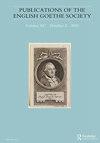Heine’s Divan: West-Eastern Voyages after Goethe
IF 0.1
3区 文学
0 LITERATURE, GERMAN, DUTCH, SCANDINAVIAN
引用次数: 0
Abstract
ABSTRACT Heinrich Heine has long been recognized as an early admirer of Goethe’s Divan. In Die romantische Schule, he issues an enthusiastic endorsement that helped popularize Goethe’s late poetry in the French-speaking world, and in his own poetic production, above all in Buch der Lieder, he repeatedly orients himself eastwards in terms of settings and designs. This article considers the language of flowers in Traumbilder I, the allegorical resonances of the Orient in the famous ‘Fichtenbaum’ poem, and the mirroring of Goethe’s Hafiz in the concluding poems of Nordsee II, ‘Fragen’, ‘Der Phönix’, and ‘Im Hafen’. Throughout the cycles of his collection, Heine embarks on West-Eastern voyages after Goethe.海涅的潜水:歌德之后的东西方航行
海涅一直被认为是歌德《Divan》的早期崇拜者。在《浪漫主义学派》中,他热情地为歌德晚期的诗歌在法语世界的普及提供了支持,在他自己的诗歌作品中,尤其是在《诗情画意》中,他在背景和设计上反复将自己定位于东方。本文考虑了《创伤》中花的语言,著名的《费希坦鲍姆》中东方的寓言共鸣,以及《北方》第二部结尾诗《Fragen》、《Der Phönix》和《Im Hafen》中歌德的哈菲兹的镜像。在他的整个收藏周期中,海涅在歌德之后开始了从西方到东方的航行。
本文章由计算机程序翻译,如有差异,请以英文原文为准。
求助全文
约1分钟内获得全文
求助全文
来源期刊

Publications of the English Goethe Society
LITERATURE, GERMAN, DUTCH, SCANDINAVIAN-
CiteScore
0.10
自引率
0.00%
发文量
15
 求助内容:
求助内容: 应助结果提醒方式:
应助结果提醒方式:


